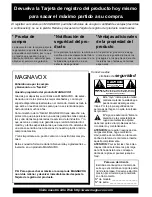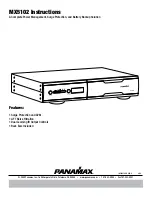
8
1. Introduction
Terminal Panel Features
. COmpUTER IN/Component Connector (mini
D-Sub 5 pin) (
→
page
)
AUDIO IN (Stereo mini Jack) (
→
page
. COmpUTER IN/Component (R/Cr, G/Y, B/Cb, h,
V) Connectors (BNC x 5) (
→
page
)
AUDIO IN (Stereo mini Jack) (
→
page
3. COmpUTER 3 (DVI-D) IN Connector (4 pin)
(hDCp compatible) (
→
page
AUDIO IN (Stereo mini Jack) (
→
page
4. COmpONENT IN (Y, Cb/pb, Cr/pr) Connectors
(RCA) (
→
page
AUDIO L/mONO, R (RCA) (
→
page
)
5. S-VIDEO IN Connector (mini DIN 4 pin) (
→
page
. VIDEO IN Connector (RCA) (
→
page
)
. VIDEO/S-VIDEO AUDIO L/mONO, R (RCA) (
→
page
)
8. mONITOR OUT Connector (mini D-Sub 5 pin)
(
→
page
9. AUDIO OUT (Stereo mini Jack) (
→
page
0. pC CONTROL port (D-Sub 9 pin) (
→
page
)
Use this port to connect your PC or control system
to control your projector via a serial cable. This
enables you to control the projector using serial
communication protocol. A commercially available
RS232C cross cable is required to use this port. You
can also control the projector by using PC Control
Utility 3.0 contained on the supplied User Support-
ware 5 CD-ROM. To do so you must first have PC
Control Utility 3.0 installed on your PC. If you are
writing your own program, typical PC control codes
are on page
.
. Remote Jack (Stereo mini Jack) (
→
page
NOTE:
• Connecting the remote cable to the REMOTE mini jack
on the terminal panel will make the wireless operation
unavailable.
• Connecting the remote cable to the REMOTE mini jack
on the terminal panel will forcibly select [NORMAL] for
[STANDBY MODE] during standby mode even though
[POWER-SAVING] has been selected from the menu.
. USB port (Type A) (
→
page
3. LAN port (RJ-45) (
→
page
4. USB Wireless LAN unit (
→
page
NOTE: A dummy cover is provided on this location of the
projector without the USB Wireless LAN Unit.
The actual appearance of the terminal panel may differ slightly from that shown in the drawing, but this does not af-
fect the projector’s performance.
WIRELESS
USB(LAN)
WIRELESS
14
7
8
10
11
13
4
12
3
2
1
6
5
9
















































